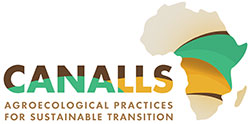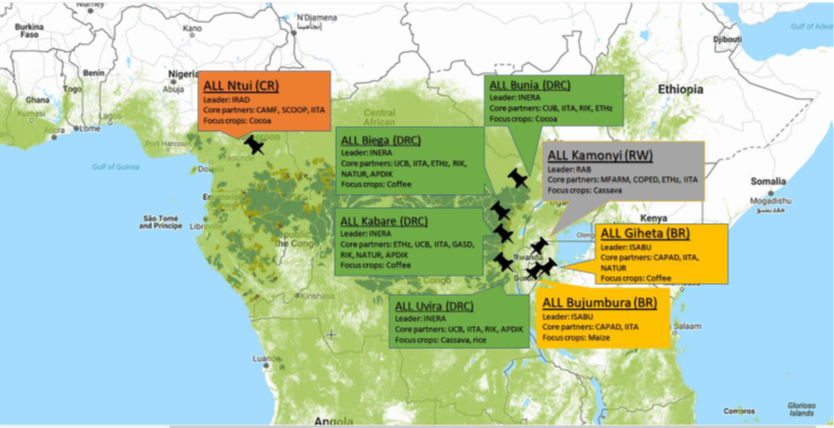The Democratic Republic of Congo (DRC) is known for its dense tropical forests, which represent about 45 percent of Africa's total, and serving as a habitat for a wide variety of plant and animal species. However, a growing population, and its dependence on farming, are putting pressure on the natural ecosystems.
South Kivu province, where 80% of the people live in poverty, has one of the highest population densities in DRC. In many regions in this province, the once abundant patches of natural vegetation are increasingly replaced by farmland, village extensions or other infrastructures, as for mining. Authentic natural vegetation, in the truest sense of the term, now thrives solely within protected areas. The increasing intensity of agriculture with less presence of trees is degrading the soil and fueling poverty and food insecurity.
Smallholder farmers in this region face unique challenges in sustaining their agricultural practices while maintaining the delicate balance of the surrounding environment. Agroecology, with its emphasis on ecological principles and sustainable farming practices, offers a promising solution. However, the challenges and perspectives of implementing agroecological practices vary greatly, depending on the specific local contexts, including the extent of forest cover.
To address the complex environmental, social, and economic challenges faced by rural communities in the region, the CANALLS project, also known as Central and Eastern Africa Agroecology Living Labs, has been initiated. This project is funded by the European Union (EU) and focuses on driving agroecological transitions in the humid tropics of Central and Eastern Africa. The project centers around the establishment of eight Agroecology Living Labs (ALLs), of which four are located in South Kivu.
Here, we briefly explore the challenges faced by smallholder farmers and the potential perspectives for agroecology across different forest cover levels.
Challenges:
Land and soil degradation: In areas with high deforestation rates and low forest cover, smallholder farmers face huge challenges related to land degradation. In regions where soil cover is scarce, soil erosion becomes a critical issue. The limited protection provided by vegetation and organic matter makes the top layer of nutrient-rich soil vulnerable to erosion by rainfall and wind. Additionally, deforestation disrupts the natural nutrient cycling processes. Trees play a crucial role in nutrient uptake from the soil and subsequent recycling of organic matter through leaf litter and decomposition. Without trees, the replenishment of nutrients in the soil is significantly reduced.
Pests and diseases: Overall, the effect of forest cover on crop pests and diseases depends on various factors such as the type of pests, crop species, proximity to forests, landscape configuration, and management practices. Generally, trees provide habitats for beneficial organisms such as predatory insects, birds, bats, and spiders, which play a vital role in naturally controlling crop pests. When tree cover is reduced, the populations of these natural enemies may decline, disrupting the balance between pests and their natural predators. However, some pests and diseases may have a broader host range, utilizing both forest plants and cultivated crops, thus increasing the risk of infestation. Balancing the benefits of forest cover for natural pest control with potential risks requires careful landscape planning and integrated pest management approaches.
Water Availability: The humid tropics are characterized by abundant rainfall. However, excessive deforestation and low forest cover can disrupt water availability, leading to water scarcity during dry periods.
Biodiversity loss and ecosystem disruption: As forest cover decreases, biodiversity loss becomes a pressing concern. Smallholder farmers in areas with low forest cover experience reduced access to ecosystem services such as pollination, pest control, water regulation and nutrient cycling. In general, ecosystems with lower forest cover are more susceptible to environmental stresses such as drought, pests, and diseases.
Perspectives for agroecology along the forest cover gradient:
High forest cover: In regions with high forest cover, agroecological practices should leverage the existing forest ecosystem services and biodiversity to enhance the resilience of agricultural landscapes. For example, existing forest canopy provides a suitable microclimate for crops like coffee or cacao, by regulating temperature, reducing heat stress, and protecting against excessive sunlight. It also helps stabilize the soil, reducing the risk of soil erosion by rainfall. The leaf litter and organic matter from the shade trees contribute to soil fertility. The diverse shade trees attract a variety of beneficial insects, birds, and bats that contribute to natural pest control.
Medium forest cover: In regions with moderate forest cover, there is potential for agroecology to contribute to forest restoration efforts. Agroforestry systems that combine food crops with native tree species can help reestablish forest cover, restore soil fertility and other ecosystem services, and diversify the income sources of smallholder farmers. An important aspect here is the maintenance of ecological connectivity between forest fragments for increased landscape resilience in the face of environmental changes. Bananas and plantains are popular food crops that can be integrated into agroforestry systems. Root crops like yams and taro, have good to moderate shade tolerance, whilst cassava and sweet potato appear to be more sensitive to shade. Agroforestry systems can, however, offer a diverse range of shade levels, and selecting suitable companion trees that provide the right amount of shade without hindering crop growth is therefore important.
Low forest cover: In areas with low or no forest cover, restoring degraded lands and reversing soil fertility decline require strategic interventions. Agroecological practices that prioritize soil rehabilitation are key here. These practices include utilizing leguminous cover crops, implementing intercropping with legumes, relay cropping with grasses, like Brachiaria, enhancing nutrient recycling at the farm level and use of manure or compost, and adopting agroforestry systems. Besides, practices that focus on water management, such as contouring, mulching and water harvesting techniques, can improve water availability and reduce the vulnerability of smallholder farmers to droughts.



